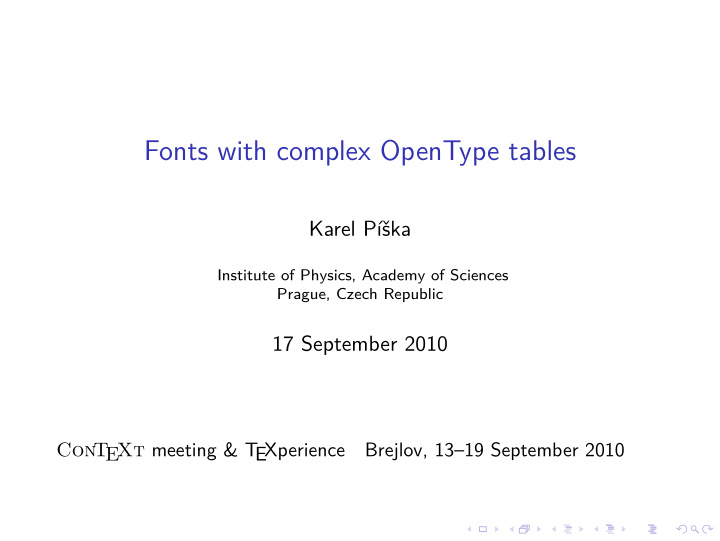



Fonts with complex OpenType tables Karel Píška Institute of Physics, Academy of Sciences Prague, Czech Republic 17 September 2010 Con T EXt meeting & T EXperience Brejlov, 13–19 September 2010
Introduction Probably not many people are designing OpenType fonts with such technical work as creating OpenType tables is. Is somebody going to produce OT fonts and OT tables? I think if someone will be interested in the matter (s)he can read my proceeding article and discuss after the presentation. Anyway, please report about my mistakes. In my presentation I want to describe principles of OT tables and overview development of the fonts with its problems more shortly and then demonstrate “How OT works” on several examples.
My starting point were two METAFONT fonts covering Czech and Georgian handwriting: the font [slabikar] designed and created in METAFONT by Petr Olšák (1997) and my [Georgian] fonts from 1998. And may aim was to create the OT versions of that fonts. Now only one common comment: I have not solved the problems with linespacing and unification: Czech and Armenian handwriting are oblique and Georgian is upright
OpenType tables principles Tables (names) in OTF (PS/Type1 flavoured OT) and in TTF* (TrueType flavoured OT) head hhea maxp OS/2 hmtx cmap loca CFF glyf* name post gasp FFTM GDEF GPOS are GSUB important
The tables in OTF/TTF are binary. Human readable form is provided by TTX [Just van Rossum] converting OT into XML and back: [ttx], [ttx-GSUB], [ttx-GPOS] is difficult for writing and editing. Therefore there are tools to define the tables in a source textual form and then compile them into binaries. VTP – VOLT project format: [hwu-vtp] FEA – Feature file specification: [hwu-fea] VOLT (Microsoft) can import VTP files makeotf (Adobe AFDKO), FontForge and commercial FontStudio (FontLab) can import FEA files and generate OT binaries. These programs allow also enter and edit OT data in interactive way. But I did not use that facilities because filling the form for hundreds rules is inefficient. I will show some of the examples I prepared in my [proceedings article].
Overview of development Creating (semi-manual editing) of source files (VTP and FEA) defining OT tables (glyph lists, features, lookups: substitution and positional rules, . . . ) Generating binaries (final OTF/TTF) with VOLT (from VTP), FontForge and AFDKO (from FEA) Proofing with VOLT, FontForge Testing with X T EX, Con T EXt E Another attempts, e.g. conversions
Problems during development Creating and editing of source files has be done in a semi-manual way. Interactive tools (in VOLT, FontForge) to entry hundreds rules is not efficient. FontForge generated wrong GSUB according Con T EXt AFDKO (Adobe) generated wrong GPOS according X T EX E I has not been successful with any conversions ( METAFONT , VOLT based TTF, FEA based OTF)
Demonstrations OT tables are instructions . . . and their interpretation and rendering is solved by text layout engines connect with operating systems or application programs VOLT and FontForge proofing tools have their own internal engines X T EX delegates font handling to libraries (ICU, ATSUI, Graphite, E . . . ) for rendering and positioning
Proofing with VOLT and FontLab I use free software and do not have the commercial FontLab Studio. VOLT is available only for MS Windows and, unfortunately, proofing Georgian is impossible in FontForge under Windows; I use FontForge on Linux.
Proofing with FontForge I have prepared several [words] for proofing and demonstration “How OT (features and lookup rules) works.” (switching keyboard layout/mapping: setxkbmap us ; setxkbmap cz ; setxkbmap ge ; )
X T EX E X T EX can read Unicode input stream, use OT fonts directly and E produce PDF with the OT fonts inside: [X L A T EX source][X L A T EX E E samples]
Con T EXt Also Con T EXt (Mark IV) offers the usage of OT fonts: [Font definitions] [ Con EXt source] [pdf] T
Con T EXt testing: showotfcomposition Con T EXt allows to trace processing of OTF features and lookups step by step: [source][pdf]
Conclusion I am able to produce OT fonts working properly (i.e. according my expectations) with X T EX ( xelatex ) and Con EXt Mark IV T E ( context ) We have two different versions of OT fonts producing the same results: VOLT based TTF FEA based OTF The fonts generated from the same FEA sources by makeotf (AFDKO) and by FontForge are different, they may contain (different!) errors or are not compatible with X T EX and E EXt . Con T Automatic conversion of substition and positioning tables between METAFONT /TFM, VOLT based TTF, FEA based OTF is impossible or does not work properly with tools available (to me).
Recommend
More recommend